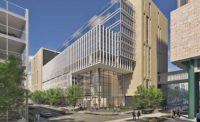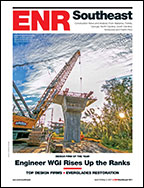Southeast contractors, beginning to sense genuine momentum in the region's building markets, are now looking forward to an upturn. But as data from ENR Southeast's latest Top Contractors survey shows, a broader regional construction market recovery remains mostly in the offing.
The survey's first indicator of a regional revival is seen in the response rate. Historically, the depth of the Southeast Top Contractors ranking has ebbed and flowed with the industry's own ups and downs. For the latest list, more than 110 firms reported their 2012 Southeast revenue, or about 20 more than participated a year ago, a sure sign of improving fortunes.
For example, cumulative 2012 regional revenue—in Florida, Georgia and the Carolinas—represented by this year's ranking increased by about 6% to $17.3 billion, up from $16.3 billion last year.
The numbers grow more mixed from there. For instance, this year's average revenue figure fell to $157.6 million, down from $179.25 million last year—and just ahead of the $153.6 million average of two years ago.
One possible reason for the declining average could be an increased number of firms participating with revenue below the average. However, among the current top 10 firms, year-over-year revenue declines were just as common as increases.
Market Gains
Despite the mixed data for 2012, contractors interviewed by ENR Southeast are optimistic about future construction opportunities.
Data from McGraw Hill Construction confirms that the volume of 2013 contracts is on the rise. The Southeast's two largest metro markets, Atlanta and Miami, are showing particularly impressive gains.
According to McGraw Hill—parent of ENR—Atlanta's construction market is taking off. Through May, the company says approximately $3.6 billion worth of new contracts have started, an estimated 80% improvement compared with the same five months of 2012. Moreover, both the nonresidential and residential sectors are showing strength, with commercial projects up 83% compared with a year ago and housing up 76%.
In Miami—which actually started its resurgence in 2012—a similar, but different, recovery is under way. Through May, McGraw Hill estimates that $2.8 billion in new contracts have moved ahead, for a 36% jump compared with 2012.
But South Florida's revival skews more to the housing sector, which is 57% higher than a year ago, with more than $1.6 billion in new projects. Even so, the area's nonresidential sector is up, too, by 14%, with about $1.1 billion in new work so far.
Positive, Negative Trends










Post a comment to this article
Report Abusive Comment